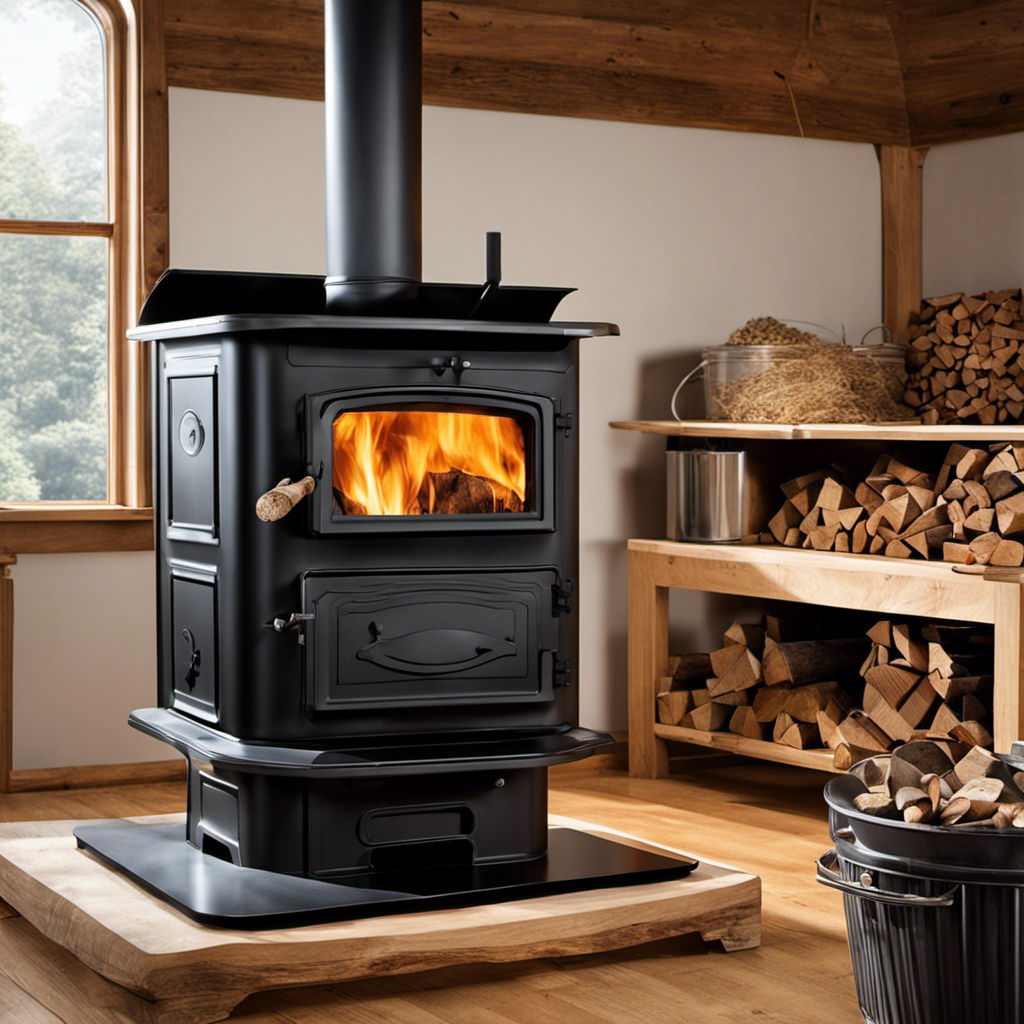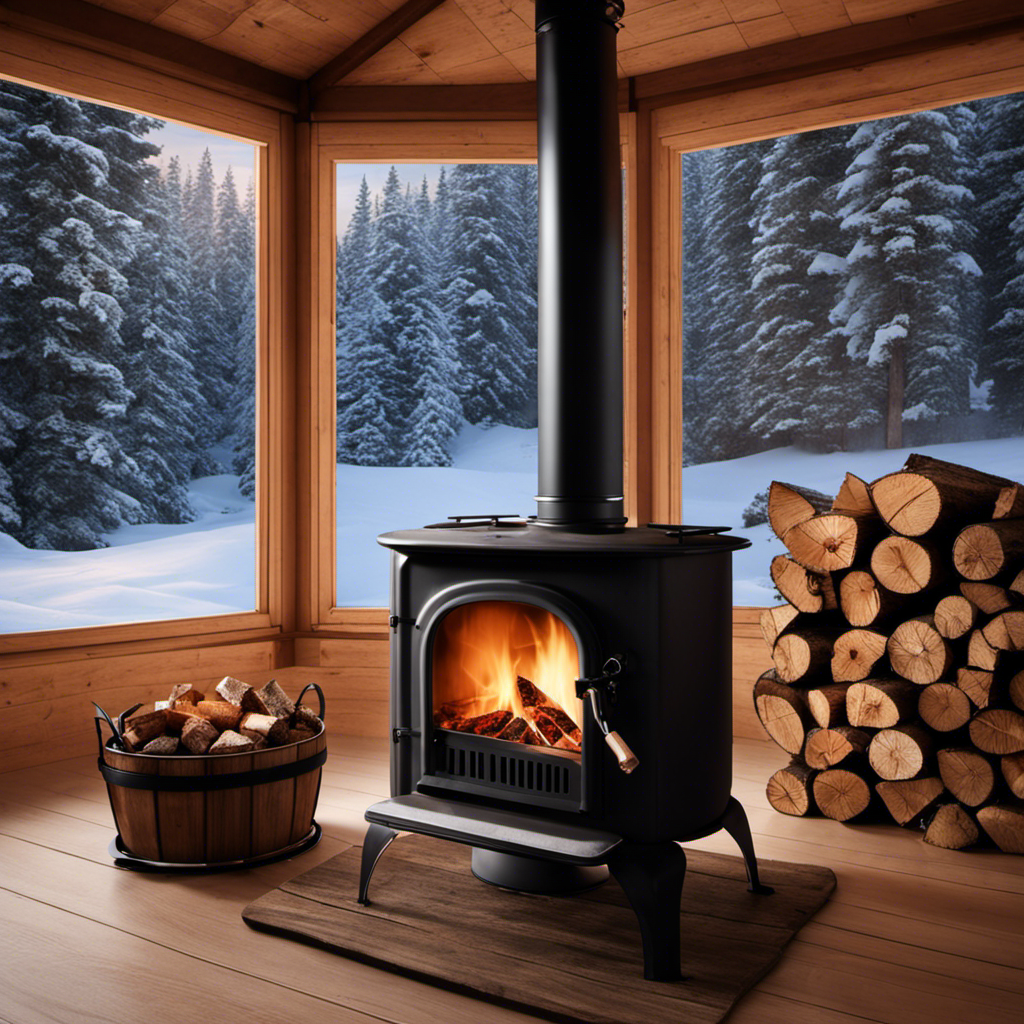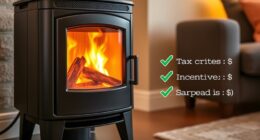Many misconceptions about wood stoves are easily debunked. Wood heat isn’t dangerous if properly installed, maintained, and used, and modern stoves are efficient and environmentally friendly when burning seasoned wood. You don’t need a rural home—wood stoves work well in cities too. They produce plenty of heat and have advanced safety features. If you want to learn how to safely enjoy wood burning and get the facts straight, keep exploring.
Key Takeaways
- Modern EPA-certified wood stoves are highly efficient, converting most of the wood into heat and reducing waste.
- Properly seasoned wood (dry for 6-12 months) ensures cleaner burns, better heat output, and less creosote buildup.
- Wood stoves are versatile and suitable for urban and rural homes, not just rural or off-grid locations.
- Advances in technology and maintenance practices significantly lower emissions and environmental impact.
- Burning green or unseasoned wood increases smoke, creosote, and safety hazards, contradicting the myth of inefficient wood heating.
Wood Stoves Are Dangerous and Unsafe

Many people assume that wood stoves are inherently dangerous and unsafe, but with proper installation and maintenance, they can be a reliable heating option. The main concerns often cited are fire risk and carbon monoxide buildup. You can greatly reduce fire risk by ensuring your stove is correctly installed and kept clear of combustible materials. Regular chimney cleaning prevents creosote buildup, which is a common cause of fires. To avoid dangerous carbon monoxide leaks, always use a carbon monoxide detector and have your stove inspected annually by a professional. Proper installation and venting practices are also essential to ensure safe operation and prevent the buildup of harmful gases. Additionally, following manufacturer guidelines for routine maintenance can help identify and address potential issues before they become hazards. Proper system performance monitoring and timely repairs are crucial for safe and efficient operation, especially if other pets are involved. When properly maintained, wood stoves operate safely, providing efficient heat without posing undue risk. Knowing these precautions helps dispel the myth that wood stoves are inherently unsafe.
Burning Wood Is Bad for the Environment
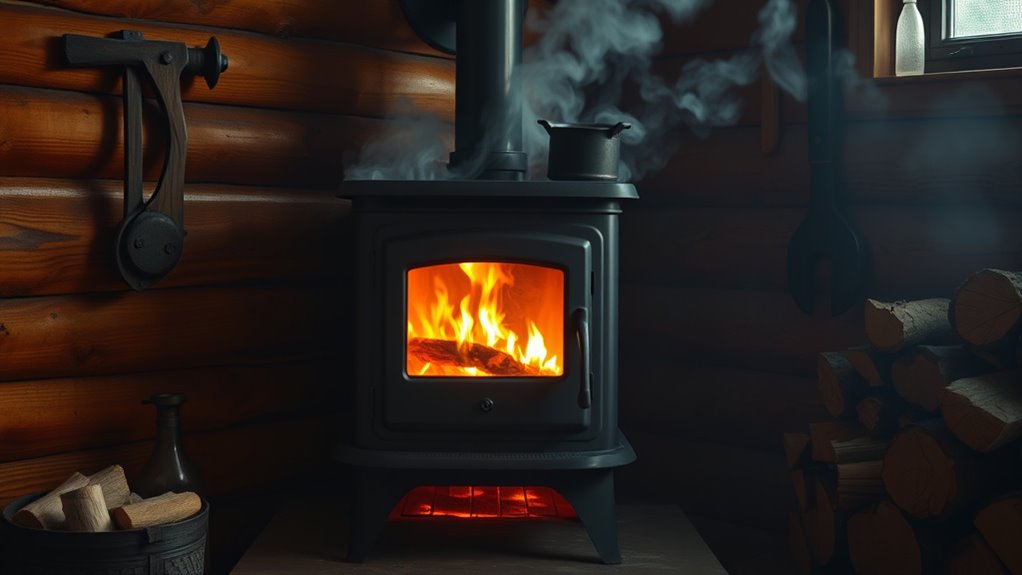
Many believe burning wood harms air quality and worsens emissions, but sustainable practices can make a difference. When you choose properly seasoned wood and modern stoves, you reduce pollutants and improve environmental impact. It’s possible to enjoy wood heat while being mindful of the planet. Implementing vertical storage solutions can further enhance efficiency and reduce the need for excess wood storage, contributing to a more sustainable heating approach. Utilizing clean-burning technology in modern stoves can significantly lower pollution levels, making wood heating a more environmentally friendly option. Additionally, staying informed about fraud detection techniques can help merchants protect their transactions from unauthorized activities, and understanding filtration systems can improve indoor air quality by capturing fine dust and allergens. Proper venting and chimney maintenance also play a crucial role in minimizing emissions and ensuring cleaner combustion.
Emissions and Air Quality
While burning wood can produce renewable heat, it also releases pollutants that impact air quality and contribute to environmental problems. Wood combustion emits particulate matter, carbon monoxide, and volatile organic compounds, which can degrade air quality and harm health. However, modern stoves equipped with emission control technology considerably reduce these pollutants. Proper operation and regular maintenance help ensure cleaner burn and lower emissions. When you use an EPA-certified stove, you minimize the environmental impact and improve air quality around your home. Emission reduction advancements in emission control make it possible to enjoy wood heat responsibly. By choosing efficient stoves and following best practices, you can reduce pollution and support cleaner air without sacrificing the benefits of renewable heating. Additionally, understanding the importance of fathers’ guidance and support can inspire responsible choices that benefit both the environment and your household. Incorporating clean-burning technologies further enhances environmental benefits and promotes healthier indoor and outdoor air quality. Investing in proper stove maintenance can significantly decrease harmful emissions and optimize performance.
Sustainable Wood Burning
Burning wood can seem like a sustainable choice for heating, but in reality, it often harms the environment. When wood is harvested irresponsibly, it disrupts ecosystems and undermines sustainable forestry practices. Properly sourced wood from well-managed forests can be part of renewable energy, but only if it’s harvested responsibly. Unsustainable logging leads to deforestation, soil erosion, and loss of biodiversity, negating any environmental benefits. To truly make wood burning sustainable, you need to guarantee your wood comes from certified forests that prioritize regeneration and conservation. Certifications and endorsements from beauty experts can help identify responsibly sourced wood products. When done correctly, burning wood can be a renewable energy source that reduces reliance on fossil fuels. However, without sustainable forestry practices, wood burning remains an environmental concern rather than a solution. Educating consumers about the importance of responsible harvesting is essential to promote environmental stewardship. Additionally, understanding the importance of sustainable forestry can guide consumers toward making environmentally responsible choices. Implementing proper harvesting techniques ensures that forest ecosystems remain healthy and productive for future generations.
Wood Stoves Are Inefficient and Wasteful
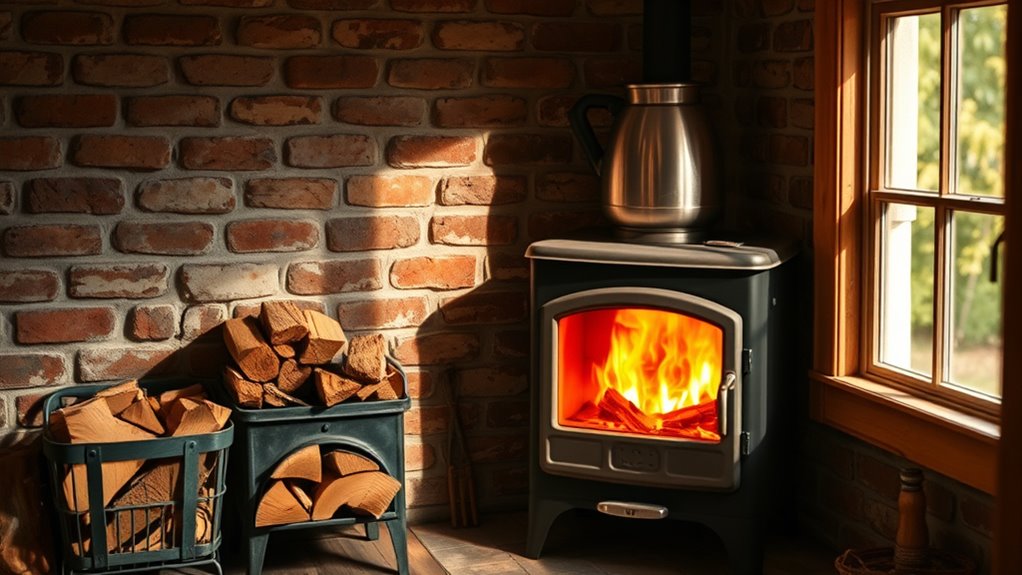
Despite common beliefs, wood stoves can be quite efficient when properly used and maintained. Many efficiency myths suggest that wood heat is inherently wasteful, but this isn’t true with modern stoves. When you choose an EPA-certified model and follow proper operation techniques, your stove can convert a high percentage of wood into usable heat, reducing waste. Waste misconceptions often stem from outdated or poorly maintained stoves that burn inefficiently, but upgrading and regular cleaning markedly improve performance. Properly seasoned wood, combined with correct loading practices, ensures more complete combustion. Additionally, advances in design and technology have significantly enhanced the efficiency of modern wood stoves, making them a viable and environmentally friendly heating option. Recognizing the importance of AI-driven diagnostics can help homeowners maintain optimal stove performance and efficiency. Modern combustion control systems further optimize burning conditions, reducing emissions and improving heat output. Incorporating advanced monitoring tools can help identify issues early and maintain peak efficiency. Implementing regular maintenance practices can greatly enhance overall efficiency and lifespan of your stove. So, rather than dismissing wood stoves as inefficient, recognize that with the right equipment and care, they can be an effective, eco-friendly heating source, dispelling the myths about wastefulness.
You Can Only Use Dry, Seasoned Wood
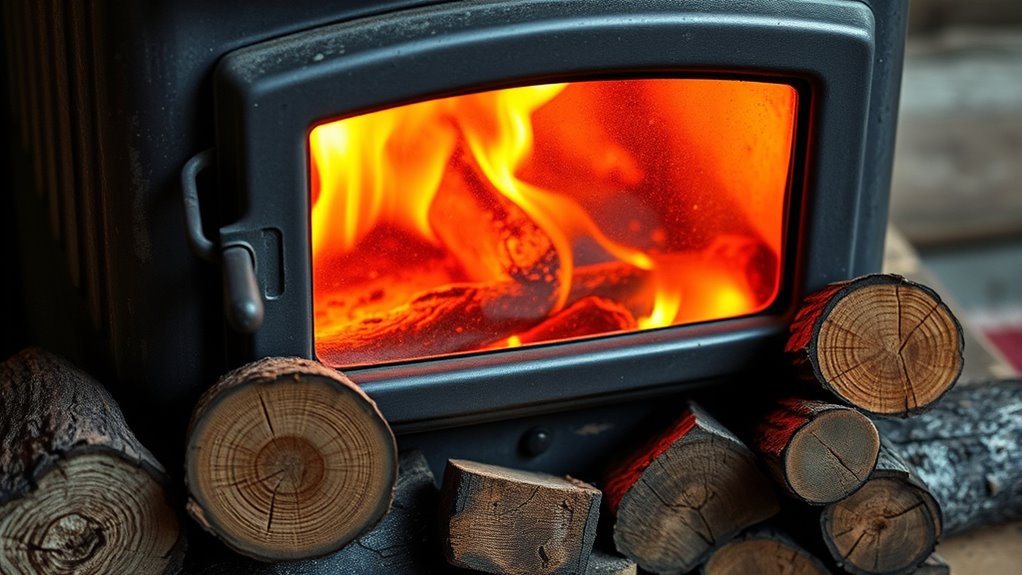
Many believe you must only burn perfectly dry, seasoned wood, but moisture content really does matter. Fresh or green wood has higher moisture levels, making it harder to ignite and less efficient. Using less-than-dry wood can lead to excess smoke and creosote buildup, affecting your stove’s performance. Additionally, understanding the artistic significance of butter can help appreciate the cultural importance of traditional practices, including proper wood burning techniques that preserve cultural heritage. Properly seasoned wood ensures optimal fire efficiency and reduces environmental impact, making your heating more sustainable. Being aware of water usage costs and how moisture influences combustion can further enhance your understanding of responsible wood heat management.
Moisture Content Matters
Using wet or unseasoned wood in your stove can cause a range of problems, from inefficient heating to excessive creosote buildup. High moisture content hampers combustion, making it harder to generate heat and increasing smoke. Proper wood seasoning reduces moisture content, ensuring cleaner burns and better heat output.
Here are four reasons why moisture content matters:
- Improved combustion efficiency
- Less creosote formation
- Increased heat output
- Reduced chimney fire risk
Always use properly seasoned wood, typically dried for at least 6-12 months, to avoid these issues. Proper wood seasoning is essential for safe, effective, and environmentally friendly wood heat. Remember, moisture content is a key factor in getting the most from your wood stove.
Fresh Wood Challenges
Fresh, unfinished wood presents significant challenges for your stove’s performance. When you use fresh wood, its moisture content is high, which makes it harder to ignite and maintain a steady burn. This excess moisture causes incomplete combustion, leading to increased creosote buildup and reduced heat output. You might notice more smoke and less warmth, which can be frustrating and unsafe. Burning wood that isn’t properly seasoned wastes fuel and puts extra strain on your stove’s components. To avoid these issues, always use dry, seasoned wood with low moisture content. Properly seasoned wood burns cleaner, hotter, and more efficiently, ensuring your stove operates safely and effectively. Remember, patience in drying your wood pays off with better heat and less maintenance.
Wood Stoves Contribute to Indoor Air Pollution

Have you ever contemplated how burning wood in your stove might be impacting the air inside your home? Wood stoves can release pollutants that affect indoor air quality if not properly maintained. Poor ventilation systems can allow smoke and particulate matter to linger, increasing health risks. Here are some key points to consider:
- Particulate matter from wood smoke can cause respiratory issues.
- Incomplete combustion releases carbon monoxide, a dangerous gas.
- Soot and creosote buildup can reduce air quality over time.
- Proper ventilation helps disperse pollutants and improves indoor air safety.
To minimize these effects, ensure your stove is well-maintained, and your ventilation systems are functioning correctly, keeping your indoor environment healthier.
They Require Excessive Maintenance and Cleaning
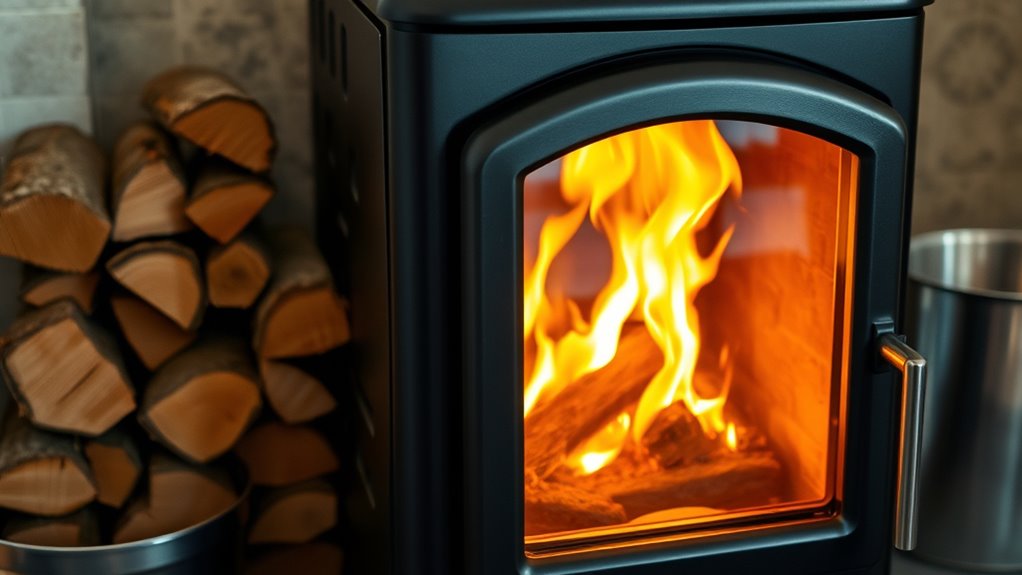
Wood stoves demand regular and often labor-intensive maintenance to operate safely and efficiently. You’ll need to schedule chimney cleaning to prevent creosote buildup, which can cause dangerous chimney fires. Regular inspection of the flue and stovepipe ensures proper airflow and reduces the risk of smoke escaping into your home. Ash disposal is also a necessary task; you should remove accumulated ash frequently to maintain good combustion and heat output. Use a metal container for safe disposal, and avoid letting ash pile up, which can restrict airflow and impact stove performance. While maintenance might seem tedious, it’s essential for safety and efficiency. With a routine cleaning schedule, your wood stove can serve you reliably without excessive effort or concern.
Wood Stoves Are Only Suitable for Rural Areas
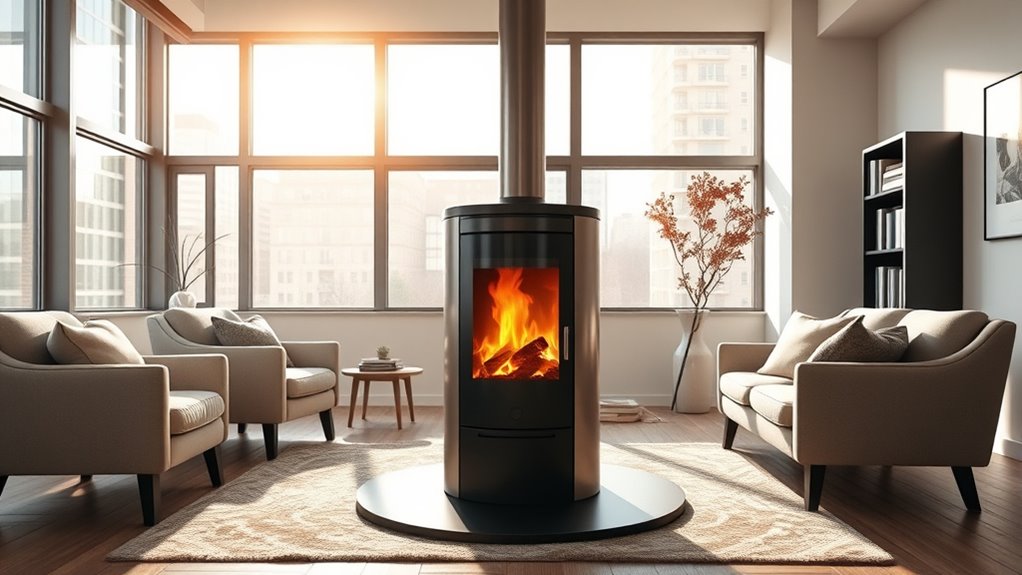
Many people assume that wood stoves are only practical in rural areas, but that’s not the case. Modern wood stoves offer rural advantages like independence from grid power and cost savings, while also fitting well in urban settings. They can be a reliable heat source in city homes with proper ventilation and space. Here are some key points:
- Urban compatibility with modern designs and safety features
- Efficient use of space in city apartments or small homes
- Reduced reliance on electric or gas heating systems
- Potential for cost savings in both rural and urban environments
Whether you’re in a rural or urban area, a wood stove can be a versatile, efficient heating option that debunks the myth of limited suitability.
Using a Wood Stove Is Too Complicated for Homeowners

Contrary to the belief that wood stoves are difficult to operate, modern models have become straightforward for homeowners to manage. You no longer need to worry about complex operation or constant adjustments. Fuel storage has also been simplified, with options like pre-cut logs or seasoned wood that burn efficiently and reduce mess. While installation complexity can seem intimidating, professional installers handle the setup, ensuring your stove fits safely and meets local codes. Once installed, using a wood stove involves basic tasks like loading wood and adjusting vents, which are intuitive. Advances in design mean maintenance is minimal, and modern stoves often include features that make operation safer and more user-friendly. Overall, managing a wood stove is accessible even for beginners.
Modern Wood Stoves Don’t Produce Much Heat
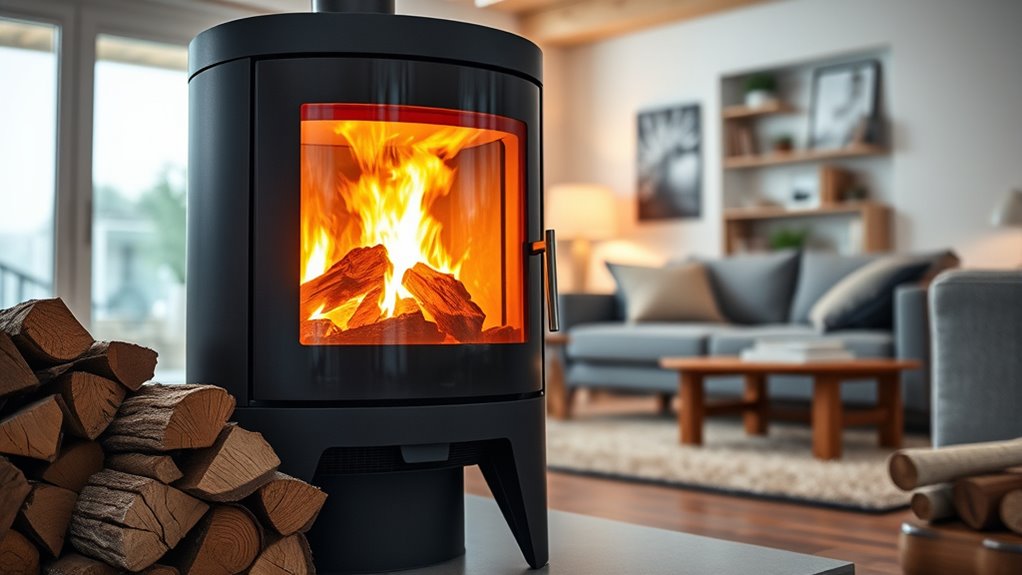
Although some believe modern wood stoves produce limited heat, advancements in design have substantially improved their efficiency and output. Today’s models generate impressive heat output, enough to warm large spaces effectively. Concerns about safety are also addressed through improved insulation and controlled combustion, making them safer to operate. Here are four key points:
Modern wood stoves now deliver high heat output safely and efficiently thanks to design advancements.
- Modern stoves have higher heat output due to better airflow and combustion technology.
- They can heat larger areas more efficiently, reducing the need for supplemental heating.
- Safety concerns are minimized with modern features like airtight doors and automatic shut-offs.
- Proper installation and maintenance ensure maximum heat output while maintaining safety standards.
These improvements debunk the myth that modern wood stoves don’t produce enough heat or pose safety risks.
Frequently Asked Questions
Can Wood Stoves Be Safely Used Indoors?
You can safely use wood stoves indoors if you follow proper safety regulations. Make certain proper ventilation to prevent indoor air from becoming polluted with smoke or harmful gases. Regularly inspect and maintain your stove to prevent fires and ensure efficient operation. Use a carbon monoxide detector, and always keep flammable materials away. When rules are followed, wood stoves provide cozy warmth without compromising indoor air safety.
Are Modern Wood Stoves Environmentally Friendly?
You might think modern wood stoves are eco-friendly, but don’t be fooled—air quality and emissions testing show they still release pollutants. While advancements reduce smoke and emissions, they aren’t completely clean. So, when you cozy up by your stove, remember that even the latest models aren’t entirely green. It’s a balancing act—warmth for you, but a reminder to contemplate air quality impacts.
How Efficient Are Current Wood Stove Models?
Current wood stove models are quite efficient, thanks to advanced combustion technology. They typically boast efficiency metrics around 70-80%, meaning you get more heat from less wood. Modern stoves optimize combustion for cleaner burning and higher heat output, reducing emissions and waste. You’ll find that these models heat your space effectively while being more environmentally friendly and cost-efficient, making them a smart choice for sustainable heating.
Is Seasoned Wood Necessary for Effective Burning?
Imagine your wood stove as a loyal horse needing the right fuel to run smoothly. Seasoned wood is like high-quality feed—dried and ready to burn efficiently. Without proper wood storage to keep your seasoned wood dry, moisture hampers combustion. Using unseasoned wood causes smoke and creosote buildup, making your stove less effective. So, for a reliable, clean burn, always store your wood properly and use seasoned wood.
Do Wood Stoves Require Professional Installation?
You should definitely have a professional install your wood stove, as it guarantees proper ventilation requirements and adherence to building codes. Professionals know how to position the stove safely, connect it to chimneys, and meet local regulations. Skipping expert help can lead to safety hazards, poor efficiency, or code violations. Trusting a licensed installer guarantees your stove operates safely and efficiently, giving you peace of mind and maximum warmth.
Conclusion
Don’t let these myths hold you back from enjoying the warmth and efficiency of a modern wood stove. With advances in technology, wood stoves are safer, cleaner, and more effective than ever. Are you ready to see how wood heat can fit into your home without the misconceptions? Take a closer look and discover the true benefits—your cozy, eco-friendly home awaits. Why settle for outdated ideas when the future of wood heating is right here?





